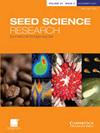Seed dormancy diversity of the mangrove plant community in Sri Lanka to assist in direct seeding and seedling transplanting restoration
IF 1.9
3区 生物学
Q2 PLANT SCIENCES
引用次数: 0
Abstract
Mangroves are one of the most important ecosystems in the world being found in the tropical–subtropical belt. Despite their significance, they have been highly disturbed due to many anthropogenic and natural causes. A significant effort has been made to restore mangroves around the world. However, a lack of information on the seed biology of mangrove species has impeded restoration. Thus, this study aimed to produce a seed dormancy profile for selected plant species of mangroves in Sri Lanka. This profile would allow restoration ecologists to better understand what kinds of dormancy are present, how to alleviate dormancy and how to best stimulate germination to generate seedlings for nursery stock or out-planting. Mature fruits/seeds were collected from coastal zone mangroves in Sri Lanka. Germination and imbibition of non-scarified and manually scarified seeds and embryo:seed length (E:S) ratio of fresh and radicle-emerged seeds were evaluated to assess the class of dormancy. Of the 30 species, seeds from 12 (40%) were non-dormant and 18 (60%) were dormant. Three dormancy classes [physiological (PD), physical (PY) and morphophysiological (MPD)] and presence of epicotyl dormancy were identified. Among species producing dormant seeds, most of them showed PD (44%). PY, MPD and presence of epicotyl dormancy were represented by 28, 17 and 11% of the species, respectively. These findings aid practitioners to craft strategies to effectively break dormancy and germinate seeds for conservation and restoration activities of mangroves.斯里兰卡红树林植物群落的种子休眠多样性有助于直播和幼苗移植恢复
红树林是世界上热带-亚热带地区最重要的生态系统之一。尽管它们意义重大,但由于许多人为和自然原因,它们一直受到高度干扰。世界各地为恢复红树林做出了重大努力。然而,缺乏有关红树林物种种子生物学的信息阻碍了恢复。因此,本研究旨在为斯里兰卡选定的红树林植物物种建立种子休眠图谱。这一概况将使恢复生态学家更好地了解存在哪些类型的休眠,如何缓解休眠,以及如何最好地刺激发芽,以产生用于苗木或室外种植的幼苗。成熟的水果/种子是从斯里兰卡沿海地区的红树林中采集的。评估未翻松和人工翻松种子的发芽和吸胀以及新鲜种子和生根种子的胚长(E:S)比,以评估休眠等级。在30个物种中,12个(40%)的种子处于非休眠状态,18个(60%)处于休眠状态。确定了三种休眠类别[生理性(PD)、物理性(PY)和形态生理性(MPD)]和存在上胚轴休眠。在产生休眠种子的物种中,大多数表现为PD(44%)。PY、MPD和存在上胚轴休眠的物种分别占28%、17%和11%。这些发现有助于从业者制定有效打破红树林休眠和发芽的策略,用于红树林的保护和恢复活动。
本文章由计算机程序翻译,如有差异,请以英文原文为准。
求助全文
约1分钟内获得全文
求助全文
来源期刊

Seed Science Research
生物-植物科学
CiteScore
3.60
自引率
4.80%
发文量
23
审稿时长
>12 weeks
期刊介绍:
Seed Science Research, the official journal of the International Society for Seed Science, is a leading international journal featuring high-quality original papers and review articles on the fundamental aspects of seed science, reviewed by internationally distinguished editors. The emphasis is on the physiology, biochemistry, molecular biology and ecology of seeds.
 求助内容:
求助内容: 应助结果提醒方式:
应助结果提醒方式:


